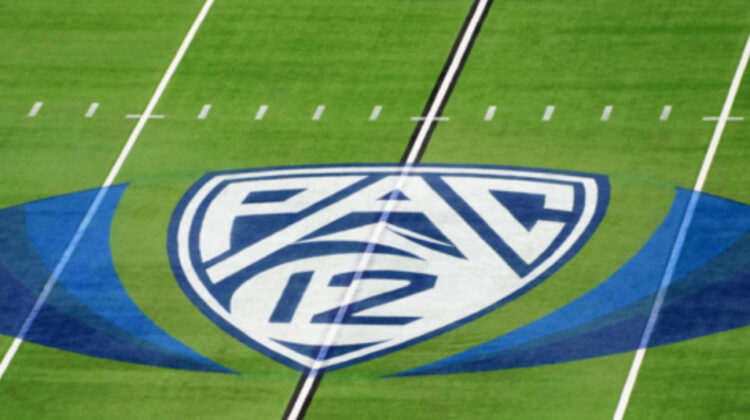It has been 244 days since USC and UCLA announced their plans to enter the Big Ten and almost as many since the Pac-12 began the process of renegotiating its media rights.
The conference spent 90 days in an exclusive window with ESPN and Fox, then took its content to the market and now, finally, is nearing the end of the saga.
On the first day of March, we are reasonably confident that resolution — in some form or fashion — will come by the first day of April.
Here are the Hotline’s predictions for the key pieces of the process …
*** Survival odds
For several months, we viewed Pac-12 survival as a 5.5-point favorite over Pac-12 extinction, which equated to a probability of about 67 percent. The conference had a two-in-three chance to successfully navigate this existential crisis.
But as the Hotline detailed a few weeks ago, time and risk move in lockstep in the realignment game.
Risk that unknown or hibernating factors can rise up to derail expectations.
Risk that institutional priorities could change or economic pressures could appear.
Risk that anxiety could lead to panic.
Risk that forces of instability could prevail.
Commissioner George Kliavkoff’s decision to take the negotiations across the holidays and into a second calendar year — “No need for a rush,” he said in December — has created an additional level of uncertainty.
As a result, our Pac-12 survival odds have changed for the first time in months, ticking down to five points.
And they will continue to decrease by a half-point every week that comes and goes without a deal.
If the end of March arrives and the same state of uncertainty still exists, then survival will be favored over extinction by merely a field goal.
*** The media valuation
We project the Pac-12’s valuation to fall within 10 percent of the Big 12’s agreement with ESPN and Fox, which will pay each school an average of $31.7 million annually starting in 2024-25.
That places the Pac-12’s range as $28.5 million (per school) annually on the low end and $34.9 million annually on the high end.
Our target number is $29.7 million.
How did we arrive at that figure? The Hotline always disagreed with the notion that the Big 12 and Pac-12 would get clobbered by the departures of Texas, Oklahoma, USC and UCLA — that their next media deals would pay less than their current deals.
That view ignored the massive increase in the value of live sports that has unfolded since the current deals were signed early in the 2010s.
In October, we set a valuation range of $38 million to $42 million per school for the reconfigured Big 12 and $35 million to $40 million per school for the Pac-12. The former had a slight advantage because of its tremendous basketball product.
Then the Big 12 renewed its agreement with ESPN and Fox instead of taking its rights to the market — a smart play by commissioner Brett Yormark because of the security it provided with the conference’s longtime network partners.
It also reset (i.e., lowered) the market for the Pac-12.
The midpoints of our October estimates were $37.5 million for the Pac-12 and $40 million for the Big 12. Put another way, we valued the former at 94 percent of the latter.
If we apply that comparative value using the Big 12’s actual average annual value ($31.7 million per school), we arrive at $29.7 million per school for the Pac-12.
And look what we have here: The Pac-12’s current deal with Fox and ESPN averages $20.8 million per school while the Big 12’s current agreement averages $22 million — the former is about 94 percent of the latter.
Yes, the Big 12 has replaced Texas and Oklahoma, while the Pac-12 hasn’t (yet) filled the hole left by the Los Angeles schools.
But don’t forget, the Longhorns and Sooners accounted for a greater percentage of the Big 12’s valuation than USC and UCLA did for the Pac-12.
And as we have stated throughout the process, any difference in valuation between the Big 12 and Pac-12 would be on the margins compared to the difference between those leagues and the SEC and Big Ten.
*** The media partners
Our best advice with regard to every aspect of the Pac-12 media rights negotiations is the following: Only an extremely tight circle of people know the details.
The Hotline has been tracking the situation closely for eight months, and we can merely take an educated guess at the outcome.
Piecing together the crumbs, we believe ESPN, Apple and Amazon are keenly interested in the content, with the possible existence of a fourth entity. An X factor, essentially.
We also believe the Pac-12’s ability to fill the 7:30 p.m. Pacific window is a valuable asset. And not just on Saturday night.
In theory, the conference could fill that window every Friday and Saturday night for 13 weeks — that’s 26 games (90 hours of programming) unopposed by competition from the NFL or other Power Five leagues.
Amazon makes the most sense for the Friday game, because it could promote the broadcast during ‘Thursday Night Football,’ while ESPN makes the most sense for the Saturday night game.
We should also point out that it’s difficult for fans in other regions to grasp how entrenched Apple and Amazon are in the culture and economics of the West Coast.
Washington president Ana Mari Cauce is the chair of the Pac-12’s Board of Directors. Her office is 3.5 miles from Amazon’s headquarters.
Stanford president Marc Tessiere-Lavigne is on the board’s agenda-driving executive committee (along with Cauce and WSU’s Kirk Schulz). His office is 14 miles from Apple’s headquarters in Cupertino.
Our sense is the presidents don’t look at the streaming giants with the wariness that might exist in other conferences. They would view partnerships as enhancing deeper connections than mere broadcast agreements.
That said, the conference needs its best football games on linear platforms (either broadcast or cable networks) in order to maximize reach to mainstream fans.
As a result, the Hotline expects a media deal with ESPN and either Apple or Amazon, and we wouldn’t rule out the possibility for both companies to be involved.
All options must be considered until we have evidence to the contrary.
The key for Kliavkoff, however, is striking a balance between the linear and streaming platforms. Admittedly, we don’t know where the presidents will draw the line, but within that broad calculation are the number of night games and the timing of the selection process.
Nothing has created more frustration across the conference footprint than the six-day selection windows — ESPN and Fox have two each (per season) — that make planning for games extremely difficult.
*** The Pac-12 Networks
As a media company with distribution deals and content available on linear platforms, the Pac-12 Networks probably will cease to exist in the summer of 2024 when its current contracts expire.
But the technology and infrastructure likely will live on.
The conference has leased 42,000 square feet of office space in the East Bay. The facility will serve as a production studio for massive amounts of video content, including Olympic sports events, that could be streamed directly to consumers or made available to a media partner.
The studio and cutting-edge technology also could be used by Apple or Amazon to produce live sports events involving the Pac-12 (or other leagues).
We expect Pac-12 football and men’s basketball games to be included in the rights agreement with one of the major media companies.
Sometime next November, the conference’s wholly-owned media company will broadcast its final football game.
*** The expansion calculation
Multiple sources believe the Pac-12 is considering three options for membership structure: add four schools, add two schools or don’t add any schools.
The final decision depends on the media deal and the relationship between inventory and valuation — whether the ability to play more games (e.g., a weekly Friday night kickoff) will increase revenue for the existing members.
Our view of the outcomes:
— Two schools: 50 percent
— Zero schools: 45 percent
— Four schools 5 percent
SMU and San Diego State seemingly sit atop the candidate list but are not the only universities Kliavkoff has evaluated for membership. (We have been unable to confirm the others.)
The calculation for expansion is comparable to the decision on streaming: The Pac-12 must assess the long-haul benefits of both.
Would a partnership with Apple or Amazon become exponentially more beneficial by the end of the decade than it appears now?
Would the SMU and SDSU football brands be markedly stronger after five or six years in the Pac-12 than they are today?
Because ultimately, the decisions made this month are about strategic position for the next six or eight years.
*** Send suggestions, comments and tips (confidentiality guaranteed) to pac12hotline@bayareanewsgroup.com or call 408-920-5716
*** Follow me on Twitter: @WilnerHotline
*** Pac-12 Hotline is not endorsed or sponsored by the Pac-12 Conference, and the views expressed herein do not necessarily reflect the views of the Conference.
Related posts:
 Pac-12 bowl projections: Major changes at the top as Oregon becomes our pick for the CFP
Pac-12 bowl projections: Major changes at the top as Oregon becomes our pick for the CFP

(AP Photo/Godofredo A. Vásquez)
Metcalfe – Pac-12 women’s basketball power ratings: Stanford showdown with #1 South Carolina Hotline mailbag: The reward (and risk) of waiting to sign a media deal, Kevin Warren, Brock Purdy, Oregon, UW and more
Hotline mailbag: The reward (and risk) of waiting to sign a media deal, Kevin Warren, Brock Purdy, Oregon, UW and more

(AP Photo/Michael Caterina, File)
Searching for lessons and looking ahead after Pac-12 WBB’s disappointing NCAA Tournament

